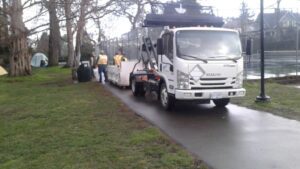The Pandora Encampment is a Pressure Cooker About to Explode
The City of Victoria has manufactured a humanitarian crisis by concentrating homeless people in a single block, and it’s about to get much worse.
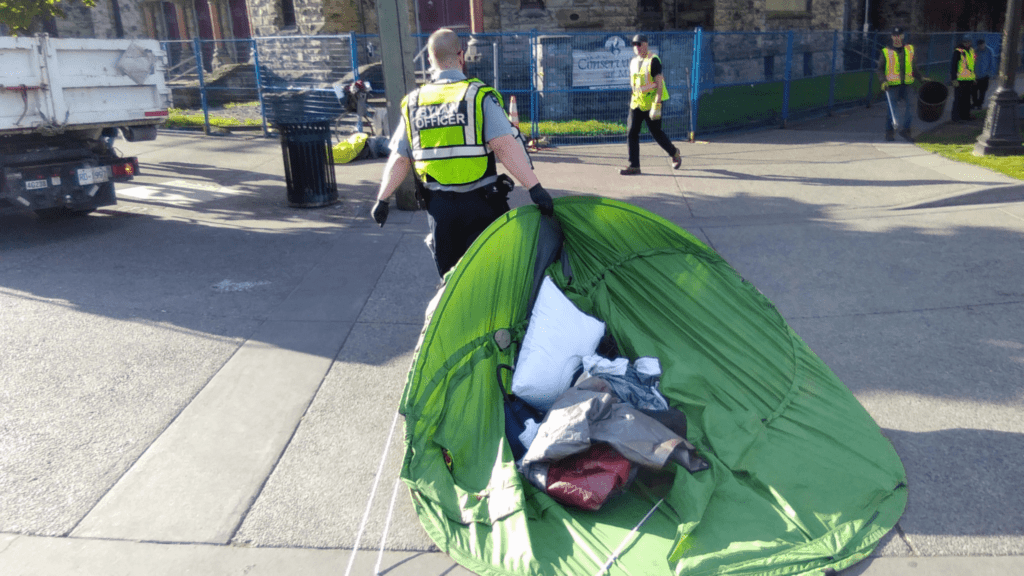
The crisis of last Thursday on the notorious 900 block of Pandora Avenue may have come as a shock to the public, but should have come at no surprise; I have been warning for a while that this would happen as a result of the City of Victoria’s policy of displacing unhoused people to nowhere.
To recapitulate, a paramedic answering a call in front of Our Place for a patient having a seizure was allegedly kicked in the face as the said patient emerged disoriented from the episode. That by itself may be regrettable, but the actual crisis started as a crowd of dozens of unhoused people swarmed paramedics and firefighters, prompting a massive police response.
As a result, first responders shall no longer intervene in the area without police support, which ironically can only make things worse since it is law enforcement’s relentless predation that has driven people on the Block feral to begin with. They are so wearied of being displaced and concentrated in a ghetto by design that they nowadays lash out at anyone wearing a uniform, and I for one refuse to condemn them.
This episode is reminiscent of a riot against Vancouver police officers at the Carnegie Centre in August 2022, when officers set out to remove tents at the overcrowded East Hastings Street encampment, only to be countered by a mob as they attempted to apprehend a suspect who resisted.
So how did we get there? Just like in Vancouver, it came down to politics and maths. Basically, the Alto administration has been closing parks to sheltering without providing alternate shelter. It amended the Parks Regulation Bylaw multiple times since assuming office, forbidding sheltering at all times at a growing number of parks and building superfluous improvements to prevent campers from coming back. Two of the five remaining parks are scheduled to be stricken off the list by August 1st, bringing it down to three locations so remote that hardly anybody uses them because it makes commuting between them and essential services impractical, especially by people with disabilities.
At the same time, it has been closing shelter space while playing a ball game with the provincial government. For example, it closed the Tiny Town transitional shelter on Caledonia Avenue, invoking public pressure from neighbours, only to reopen it six months later after BC Housing agreed to invest in it. To put it simply, it exploited a humanitarian crisis of its own making to get more government funding, and in the meantime an additional thirty people were forced to sleep outdoors.
The city can hardly claim to be cash-strapped. The council has just unveiled a $11.2 million Centennial Square revitalisation project featuring a most controversial splash park nobody asked for. This last item, by the way, has only one conceivable purpose: just like the aforementioned park improvements, it is meant to chase away homeless people from the square. It exploits a notwithstanding clause in the BC drug decriminalisation pilot forbidding illicit drug use within 15 metres of a spray pool. As for the homeless people who don’t use drugs, well the sprays still come in handy, don’t they.
It is particularly rich then for Councillors Dave Thompson and Krista Loughton to beg the provincial government for funds to install temporary washrooms on the Pandora block. Right after building one on Broughton Street several blocks away, of course.
The shortage of shelter space is nothing new. Our Place Society CEO Julian Daly has been calling for more sheltering options for a while, notably in a contentious opinion piece published by the Times Colonist. I have reached out to Our Place for comments; Director of Communications Grant McKenzie, when asked about how he felt about recent park closures leading to an acute concentration of unsheltered people on the Block, replied that “People shouldn’t sleep in parks, sidewalks, or doorways. People belong in homes and shelters.”
While this option may seem unrealistic at the peak of this manufactured crisis, I have to commend him for taking a stand at least. When asked to choose between allowing outdoor sheltering and providing more shelter space, he chose the latter. The city council, in contrast, refuses this choice altogether by denying both options.
Councillor Marg Gardiner, when questioned about the rationale for her vote in favour of closing Irving Park and Vic West Park to sheltering, replied she is in support of this because it puts pressure on higher levels of government to act to address the increasing numbers of homeless people. Of course there has never been a more crooked argument, since it obviously puts pressure not on the government, but on members of the unhoused community being kicked around like soccer balls in an ever narrowing room—until those doing the kicking end up taking a rebounding ball in the face.
Legally, the City of Victoria must choose between providing more shelter and relaxing its sheltering bylaw. The matter has been settled by the BC Supreme Court in City of Victoria v. Adams in 2008, and the judgement held on appeal. When the city sought to evict nine Cridge Park encampment residents, the defendants responded by raising a constitutional challenge under Article 7 of the Canadian Charter of Rights and Freedoms, which guarantees the life, safety, and security of the person, a right which primes over the public interest in enjoying park amenities.
Notably, the decision states that municipal bylaws cannot prevent sheltering in parks if there is insufficient shelter space, and allows erecting temporary structures to protect oneself from the elements. It also guarantees the right to sleep, the deprivation thereof being considered a form of torture. These criteria have been asserted in ulterior decisions, such as City of Abbotsford v. Shantz in 2015.
Let’s do the math together and see how the current sheltering bylaw holds against these legal precedents. In March of last year there were at least 1665 unhoused people in Victoria, 242 of which were unsheltered. This latter figure is of course conservative, as not every unsheltered person would be found on the night of the survey or accept to complete the questionnaire, something I can attest as an intake volunteer for the initiative (confidentiality agreement notwithstanding); for all we know, the actual figure could be twice as large.
While the number of available seasonal or emergency shelter mats is similarly difficult to assess, my latest estimate after conducting some research puts that figure at about 200 mats, insufficient for the 282 respondents who were emergency sheltered at the time of the survey last year. In any case, shelters are known to operate at capacity all year long, even though waiting lists are shorter during summer when the weather is more clement.
As for park capacity under the bylaw, it can be determined using the city’s maps. Given a 7x7m area per camper, I obtained the following estimates: 20 for Gonzales Park, 39 for Irving Park, 51 for Oaklands Park, 21 for Pemberton Park, and 55 for Vic West Park, for a total of 186. The upcoming closure of Irving and Vic West would slash that number in half, down to 92.
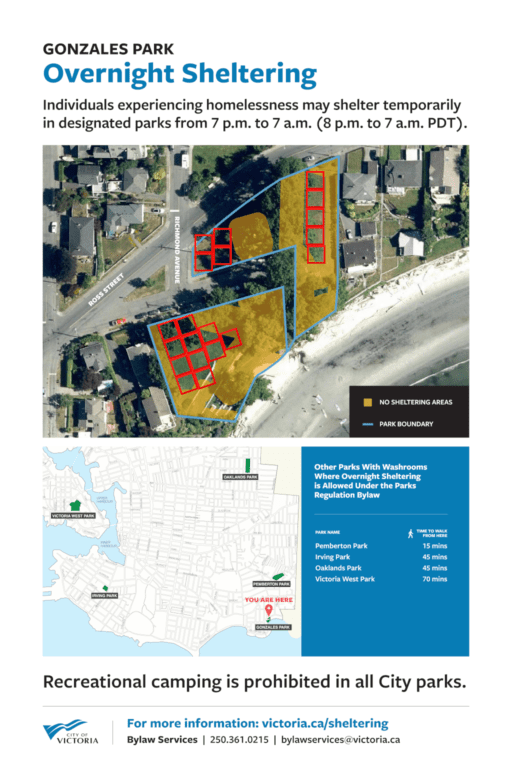
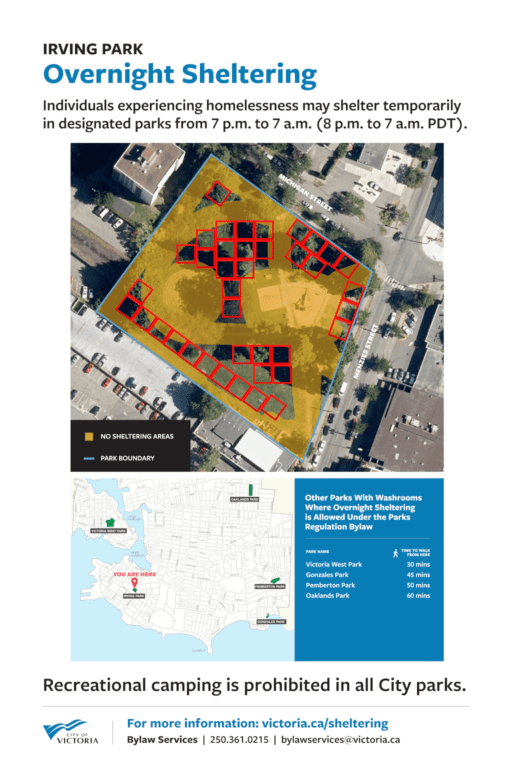
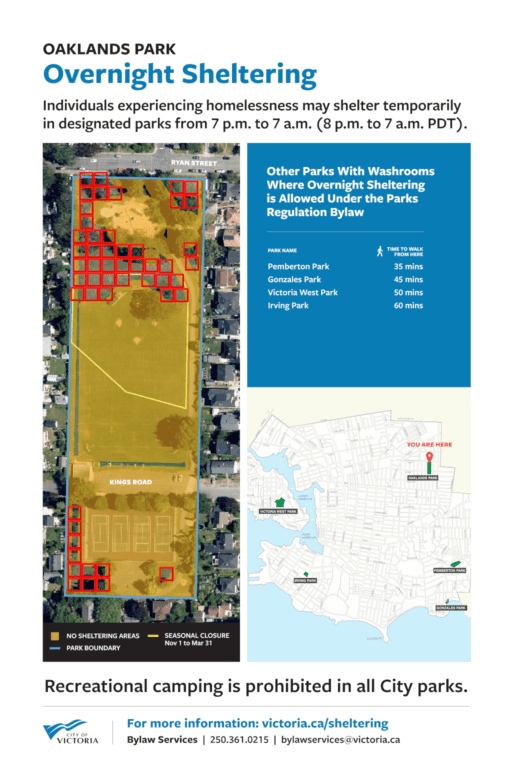
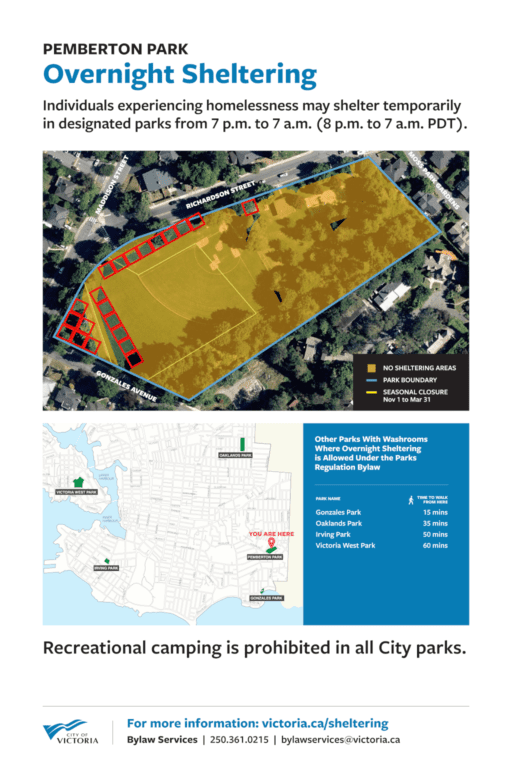
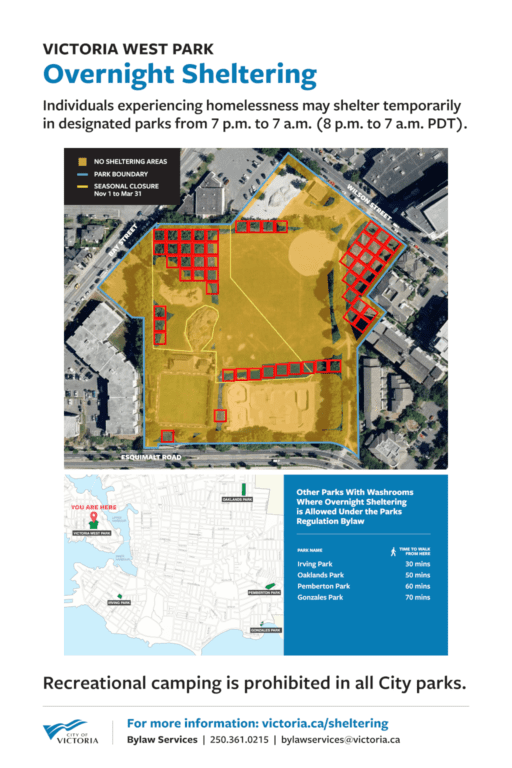
Of course my methodology for the above is Photoshop, so to speak. I did not survey the terrain to determine whether any given emplacement was practical. Some of these spots may have rocks, trees, slopes, trails, benches, or sandpits. In practice, I would bring down these estimates to 120 and 60 respectively, which look more realistic.
No matter how I count it, the current deficit reaches in the hundreds of disenfranchised human beings chased away like stray dogs, and closing two more parks will make things even worse. Of course city councillors know all of this, but hey, who’s going to fight them in court, homeless people? Well they better watch out, because there is ample precedent for this, including a landmark case in this very city.
Another Charter challenge may compel members of the council to seek a way out, just like all but two on the previous council declined to run for reelection in 2022—and one of them lost his seat anyway. In the end, politician displacement may be the only way to counter their own policy of displacement, by giving them a taste of their own medicine.
I have reached out to council members and the Victoria Police Department requesting comments. Predictably, none replied by deadline. UPDATE 2024/07/19: VicPD just replied with a link to an official statement by Chief Manak from last week promising more police presence on the Block: “Our strategy will include a marked increase in the visible police presence in the 900-block of Pandora Avenue as we rebuild relationships with our street community.” Guess where I stand on this.
UPDATE 2024/07/16: Councillor Stephen Hammond has just introduced a motion to be heard next Thursday, putting this crisis on top of the Council’s agenda. Whether it leads to a relaxing of the Parks Relocation Bylaw or instead a crackdown on Pandora Avenue remains to be seen.
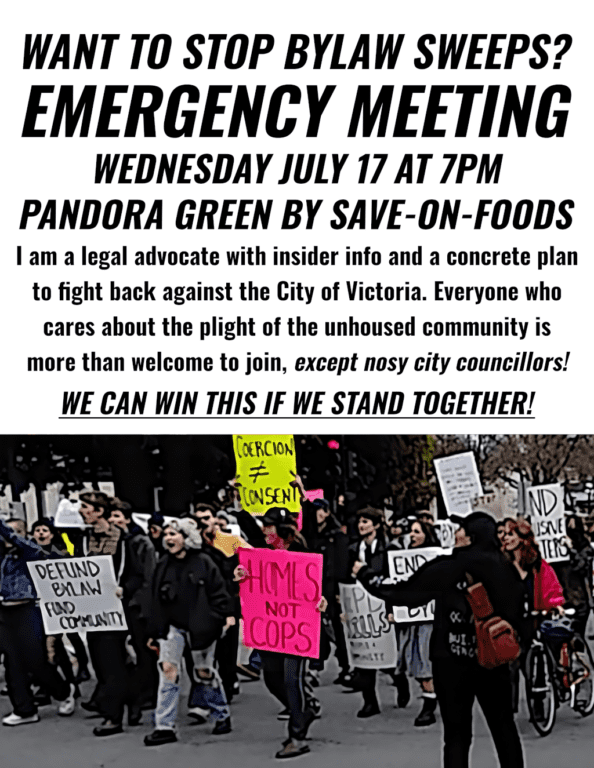
Discover more from Rulebreakers
Subscribe to get the latest posts sent to your email.



